
In the above graph, the filled circles are measured data, and the lines are model fits with 4 free parameters.
Sample IV curves for a bolometer at multiple temperatures:

In the above graph, the filled circles are measured data, and the lines are
model fits with 4 free parameters.
The preliminary summary of bolometer parameters is as follows:
G0 test array 5347 LH1
Data at 330, 440, 597, 742, 985, 4243 mK (pixels 1-16)
Data at 329, 448, 604, 744, 974, 4261 mK (pixels 17-32)
Updated 21 Apr 2000, 09:45 PDT
R = R0 exp(sqrt(T0/T))
G = G0 T^beta
R*
R0 T0 0.3 K G0=G(1 K) G(0.3 K)* G(0.5 K)
bol/grp ohms K Mohms W/K^(beta+1) beta W/K W/K
------- ---- ----- ----- ------------ ---- --------- ---------
01 mem. 1844 26.25 21.3 23.3 e-9 0.55 12.1 e-9 15.9 e-9
02 ?? 1290 25.58 13.2 1.07e-9 1.32
03 ?? 1365 25.51 13.8 1.20e-9 1.19 0.29 e-9 0.53 e-9
04 ?? 1401 25.31 13.7 0.94e-9 1.15
05 3D 1953 26.94 25.5 24.4 e-9 1.97
06 3D 1956 27.16 26.5 24.1 e-9 1.96 2.28 e-9 6.19 e-9
07 3D 2147 27.11 28.9 19.4 e-9 1.77
08 3C 2127 26.93 27.7 2.24e-9 1.20
09 3C 1844 27.58 26.9 2.66e-9 1.38 0.51 e-9 1.02 e-9
10 3C 1898 27.05 25.2 2.61e-9 1.35
11 3B 1934 28.40 32.5 24.2 e-9 2.03
12 3B 1908 28.51 32.7 25.1 e-9 2.06 2.10 e-9 6.02 e-9
13 3B 1869 28.76 33.4 27.8 e-9 2.14
14 3A 1840 28.67 32.4 4.08e-9 1.44
15 3A 1951 28.41 32.9 3.80e-9 1.42 0.69 e-9 1.42 e-9
16 3A 1924 28.37 32.2 3.89e-9 1.41
17 2D 1893 28.73 33.7 38.4 e-9 2.63
18 2D 1899 28.90 34.8 38.7 e-9 2.66 1.57 e-9 6.12 e-9
19 2D 1981 28.82 35.8 36.7 e-9 2.65
20 2C 2025 28.51 34.7 1.17e-9 1.35
21 2C 1839 28.97 34.1 1.31e-9 1.43 0.23 e-9 0.49 e-9
22 2C 1920 28.91 35.2 1.26e-9 1.40
23 2B 1957 29.47 39.4 1.21e-9 1.37
24 2B 2038 29.15 38.9 1.17e-9 1.34 0.23 e-9 0.46 e-9
25 2B 1929 29.84 41.4 1.25e-9 1.40
26 2A 1871 30.40 44.0 42.4 e-9 2.76
27 2A 2019 29.93 44.0 37.3 e-9 2.62 1.59 e-9 6.07 e-9
28 2A 1952 30.41 46.0 40.0 e-9 2.69
29 1A 1836 31.16 49.0 20.0 e-9 2.74
30 1A 1788 31.95 54.2 20.7 e-9 2.80 0.71 e-9 2.97 e-9
31 1A 1927 31.34 52.9 18.1 e-9 2.68
32 mem. 1814 32.12 56.5 72.9 e-9 1.58 10.9 e-9 24.4 e-9
* extrapolation
Resistance
Bolometer Mohm
--------- ----------
1 15.6
9 19
12 23
15 22
24 28
32 36.4
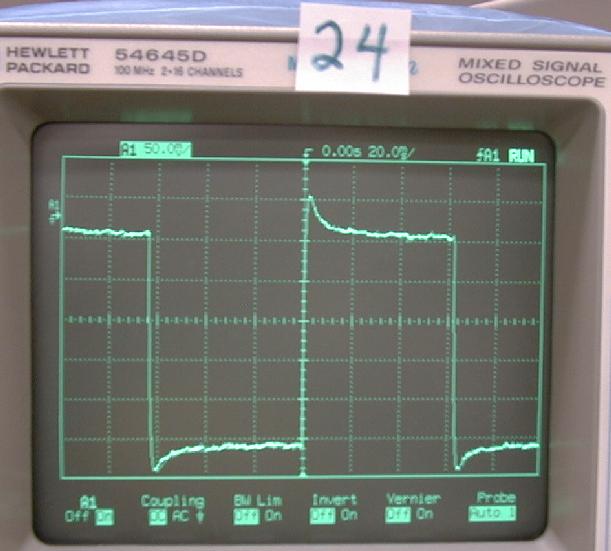

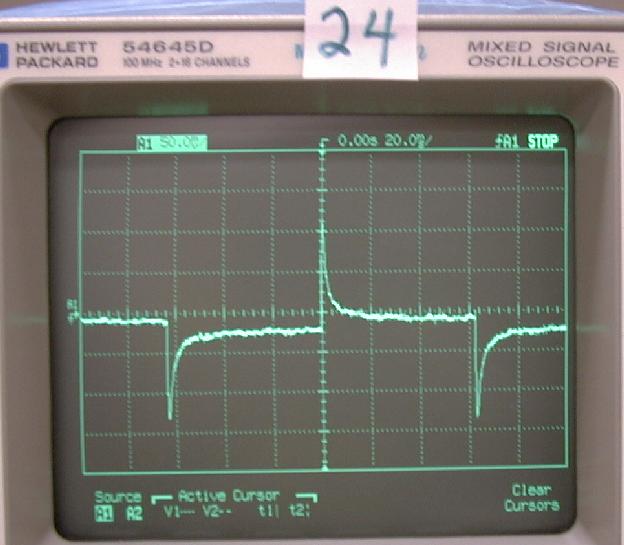
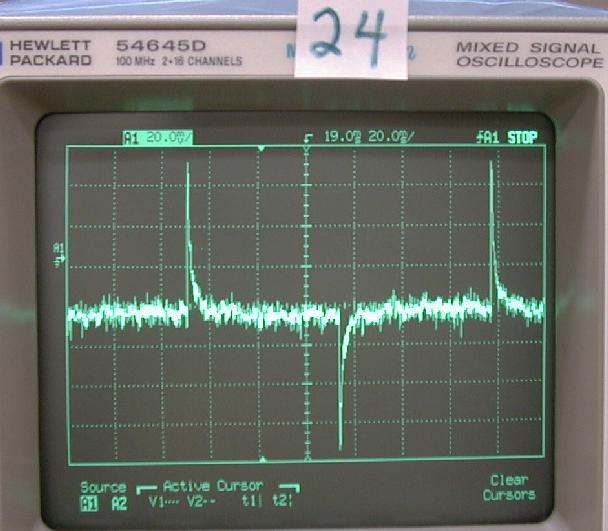
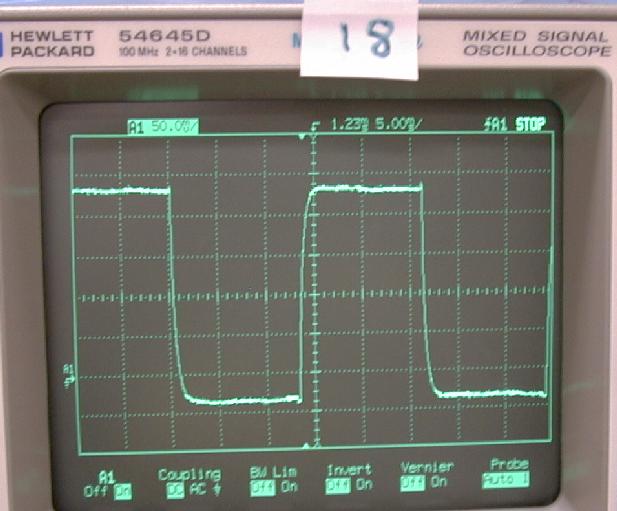
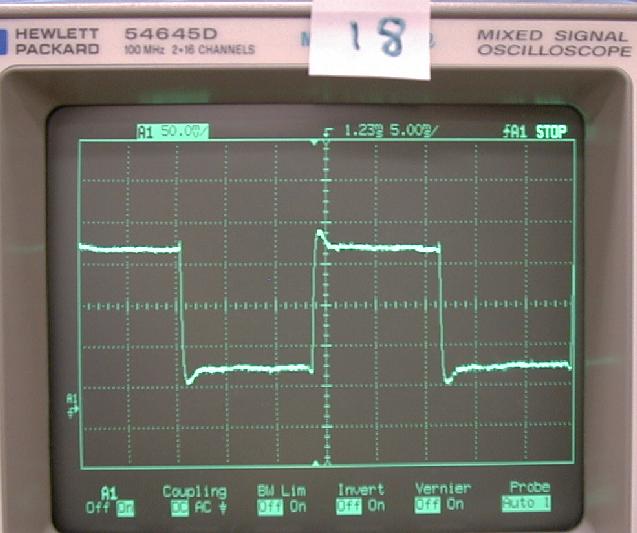
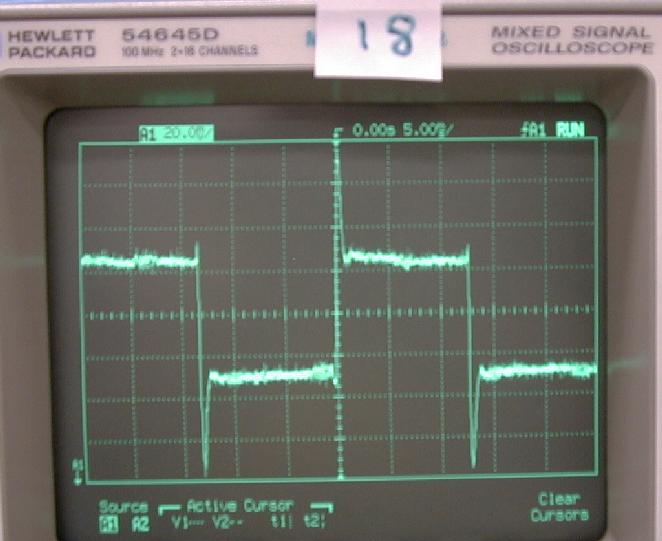
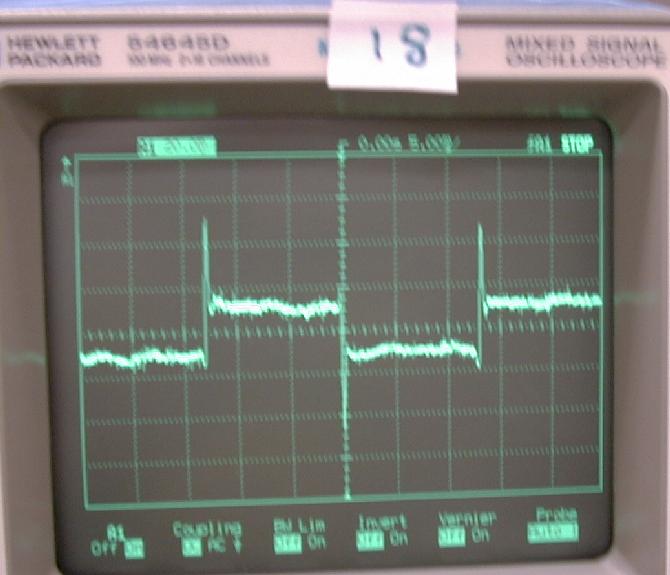
Other changes to the system include using only 3 of 4 G10 support tubes, only 2 of 4 manganin cables, avoidance of the surface mount connectors on the detector board, and using gold leaf between the INVAR base plate, detector board, heat strap, and GRT interfaces.
Sample IV curves for all bolometers at a single temperature:
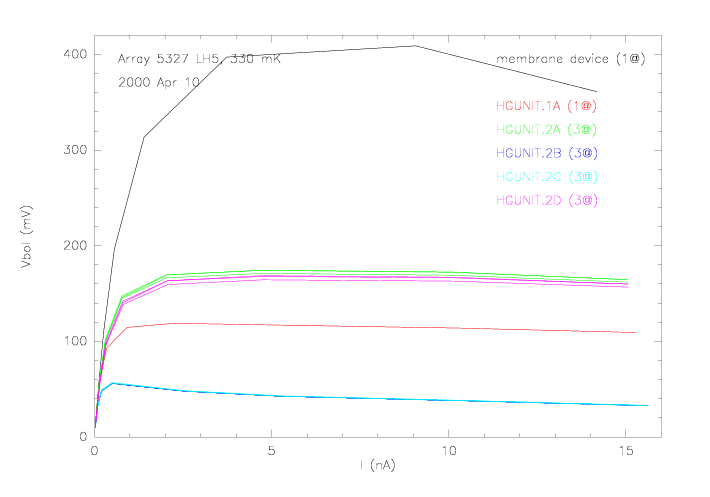
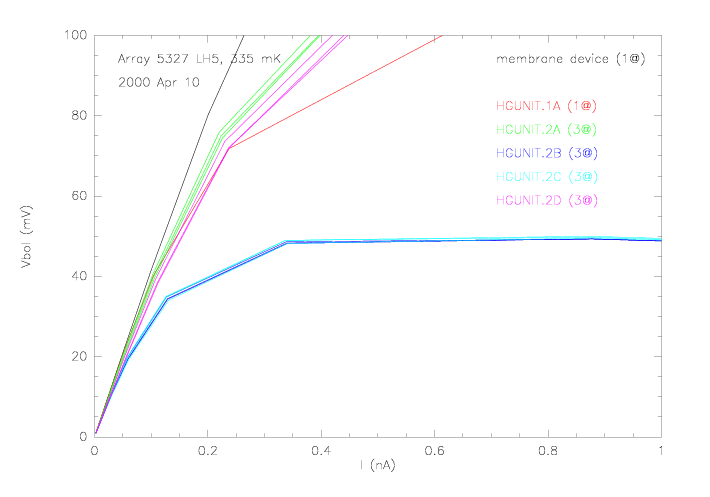
IV curves for a bolometer at multiple temperatures:

In the above graph, the filled circles are measured data, and the lines are
model fits with 4 free parameters.
The preliminary summary of bolometer parameters is as follows:
G0 test array 5327 LH5
Data at 328, 342, 389, 467, 651, 860, 962, 4127 mK
Updated 16 Apr 2000, 16:10 PDT
R = R0 exp(sqrt(T0/T))
G = G0 T^beta
R0 T0 G0=G(1 K) G(0.3 K)* G(0.5 K)
bol./grp. ohms K W/K^(beta+1) beta W/K W/K
--------- ---- ----- ------------ ---- --------- ---------
17 2D 1175 51.70 65.6 e-9 2.92
18 2D 1193 51.94 65.5 e-9 2.91 1.97 e-9 8.71 e-9
19 2D 1242 50.99 63.5 e-9 2.79
20 2C 1400 49.64 1.61e-9 1.24
21 2C 1271 51.22 1.70e-9 1.36 0.33 e-9 0.66 e-9
22 2C 1275 51.06 1.72e-9 1.35
23 2B 1354 50.20 1.65e-9 1.29
24 2B 1403 49.92 1.62e-9 1.28 0.35 e-9 0.67 e-9
25 2B 1304 50.94 1.67e-9 1.35
26 2A 1228 52.05 63.8 e-9 2.88
27 2A 1291 51.77 62.0 e-9 2.83 2.05 e-9 8.72 e-9
28 2A 1268 51.47 63.7 e-9 2.80
29 1A 1232 52.47 25.4 e-9 2.69 1.00 e-9 3.93 e-9
32 mem. 1243 52.25 128 e-9 2.40 7.12 e-9 24.3 e-9
* extrapolation; may not be accurate
Here is a Postscript summary of the bolometer recipes to associate with the group specification in the above table.
 graph of R vs. T
graph of R vs. T

A fit to the data with good thermometry yields:
Label ND R0 (ohms) T0 (K) ----- ---- --------- ------ 5250a 0.6 2570 81.8 5250b 0.6 3880 74.6 5327 0.7 1750 48.9 5347 0.75 2090 25.7
Additional plots:
Christine's plot 4/07/00
Mino's ND=0.7 PDF plot
Mino's ND=0.75 PDF plot
A fit to the data from the purple Dewar experiment only yields:
Label ND R0 (ohms) T0 (K) ----- ---- --------- ------ 5306 0.65 1670 67.3 5327 0.7 2100 42.7 5347 0.75 2380 23.2
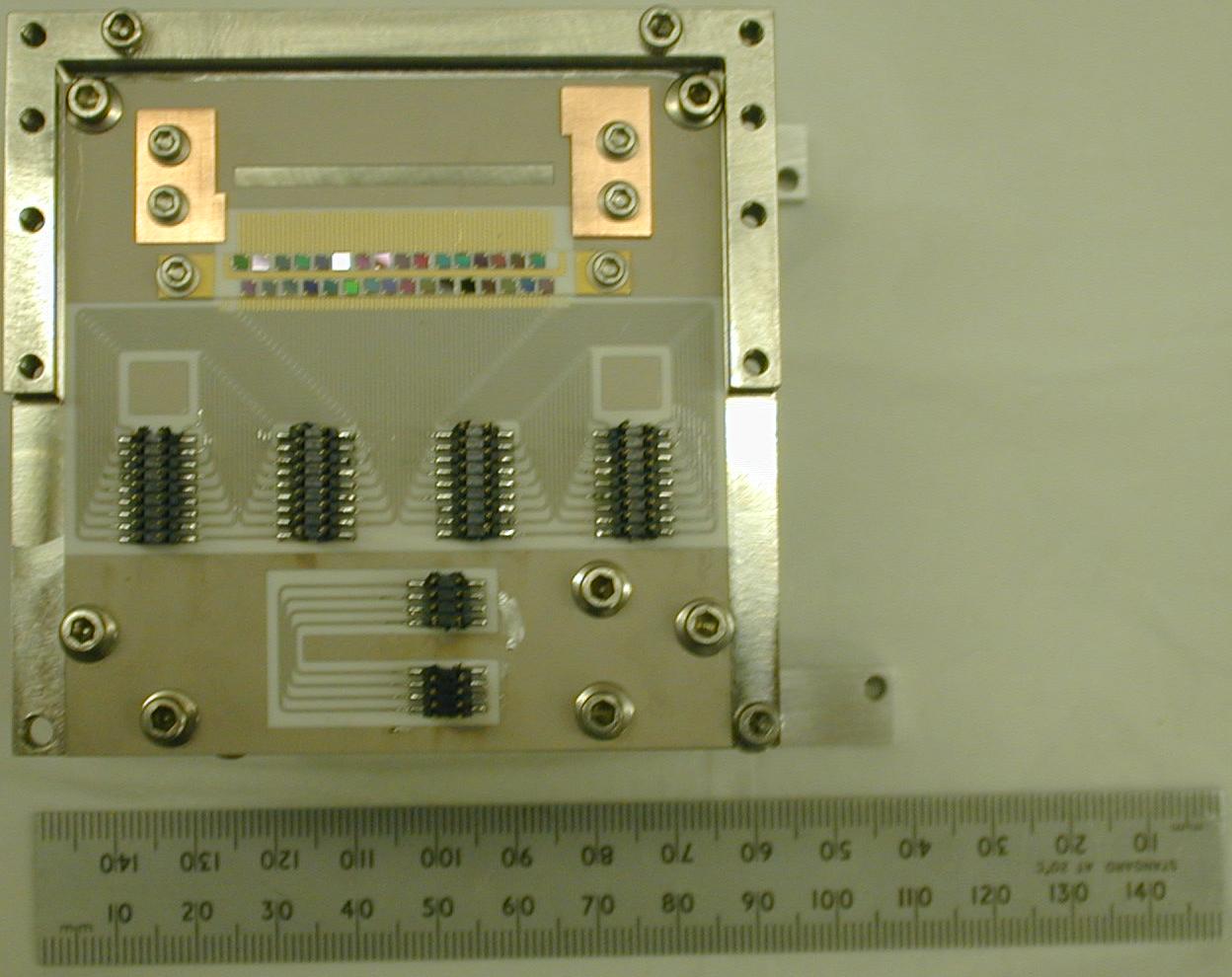
Since we will only have JFET modules to service 16 bolometers, two cooldowns will be required to test a single array. Given two arrays, we will need 4 cooldowns, with tests lasting approximately 1 month.